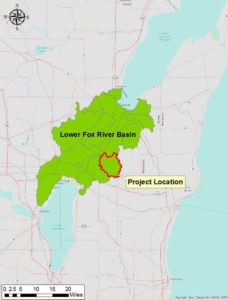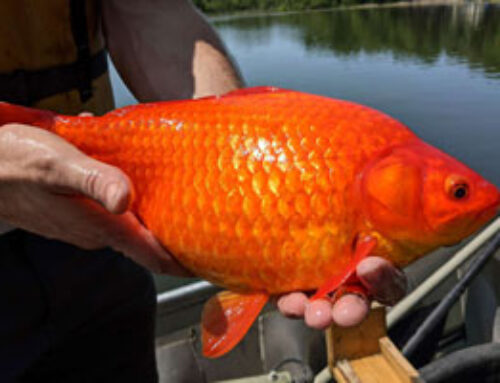The Plum Creek and Kankapot Creek watersheds, located near the villages of Kaukauna and Wrightstown in northeast Wisconsin, were identified in the Lower Fox River Total Maximum Daily Load (2012) plan as one of the highest contributing watersheds to the Lower Fox River for sediment and phosphorus pollution.
Sediment and phosphorus loading from the landscape within these watersheds have resulted with water quality issues within the creeks themselves, in the Lower Fox River and also the Bay of Green Bay.
In order to address water quality issues, a “Nonpoint Source Implementation Plan” was prepared for these watersheds in 2014. Since this plan was creating, funding has been utilized to implement a number of agricultural conservation practices within the watershed, with the Fox-Wolf Watershed Alliance (FWWA) playing a major role. Funding through the Great Lakes Restoration Initiative has been utilized to begin the process of reducing the amount of sediment and phosphorus delivery to thee creeks and ultimately, the Lower Fox River and Bay of Green Bay. The FWWA GLRI Projects Team have been busy promoting cover crop planting, no till or reduced tillage farming, construction of; treatment wetlands, conservation buffer strips, grassed waterways and streambank protections. Previous “The Source” posts have highlighted many of our projects.



PROJECT PARTNERS






With the implementation plan in place for the past 5 years, project staff felt it was time to review the plan in order to gauge the progress towards reducing sediment and phosphorus inputs to the Plum and Kankapot Creeks.
The original goals listed in the plan indicated the need to reduce the following, yearly inputs:
- Plum Creek: 23,799 lbs/yr of Phosphorus & 8,336,265 lbs/yr of Total Suspended Solids
- Kankapot Creek: 14,060 lbs/yr of Phosphorus & 4,142,164 lbs/yr of Total Suspended Solids
Initial analysis of the practices that have been installed from 2015 to 2018 indicate the following, average input reductions (note that these reductions are for both the Plum and Kankapot Creek watersheds, combined and also encompass various entities and funding sources):
- For Cover Crops: 1263 lbs/yr of Phosphorus & 146 tons/yr (292,000 lbs/yr) of Total Suspended Solids
- For Buffer Strips: 211 lbs/yr of Phosphorus & 19 tons/yr (38,000 lbs/yr) of Total Suspended Solids
- For Streambank Protection Projects: 82 lbs/yr of Phosphorus & 59 tons/yr (118,000 lbs/yr) of Total Suspended Solids
In addition to the above reductions:
- Nutrient management planning has provided an additional total of 364 lbs of Phosphorus reductions
- Barnyard Runoff and Waste Storage projects have provided a total of 467 lbs of Phosphorus reductions
- Other projects (such as Treatment Wetlands) and practices (such as conversion to grazing) have provided additional reductions of; 743 tons (1,486,000 lbs) of Total Suspended Solids & 3,767 lbs of Phosphorus
- Conservation practices such as grassed waterways or concentrated flow area treatments have attributed 474 tons (948,000 lbs) of Total Suspended Solid & 759 lbs of Phosphorus reductions.
A special thanks to Sarah Francart (Outagamie County Land Conservation Department) for putting together this data.
Questions, Comments or Suggestions…
Contact Chad VandenLangenberg (GLRI Projects Coordinator, Fox Wolf Watershed Alliance) at
chad@fwwa.org or 920.915-5767






